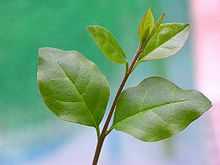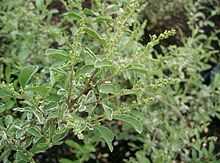Ligustrum sinense
| Ligustrum sinense | |
|---|---|
 | |
| Scientific classification | |
| Kingdom: | Plantae |
| (unranked): | Angiosperms |
| (unranked): | Eudicots |
| (unranked): | Asterids |
| Order: | Lamiales |
| Family: | Oleaceae |
| Tribe: | Oleeae |
| Genus: | Ligustrum |
| Species: | L. sinense |
| Binomial name | |
| Ligustrum sinense Lour. | |
Ligustrum sinense (Chinese Privet; syn. L. villosum), in Mandarin; 杻 (pinyin: chǒu) is a species of privet, native to China, Taiwan and Vietnam.[1]
It is an deciduous shrub growing to 2–7 m tall, with densely hairy shoots. The leaves are opposite, 2–7 cm long and 1–3 cm broad, rarely larger, with an entire margin and a 2–8 mm petiole. The flowers are white, with a four-lobed corolla 3.5–5.5 mm long. The fruit is subglobose, 5–8 mm diameter.[1]
The following varieties are accepted by the Flora of China:[1]
- Ligustrum sinense var. sinense
- Ligustrum sinense var. concavum M.C.Chang
- Ligustrum sinense var. coryanum (W.W.Smith) Handel-Mazzetti
- Ligustrum sinense var. dissimile S.J.Hao
- Ligustrum sinense var. luodianense M.C.Chang
- Ligustrum sinense var. myrianthum (Diels) Hoefker
- Ligustrum sinense var. opienense Y.C.Yang
- Ligustrum sinense var. rugosulum (W.W.Smith) M.C.Chang
Cultivation and uses

It is cultivated as an ornamental plant and for hedges. Several cultivars have been selected, including the very floriferous 'Multiflorum', the variegated cultivar 'Variegatum', and the dwarf cultivar 'Wimbei' growing to 0.5 m and with leaves only 6 mm long.[2]
It has also been used as a popular bonsai tree.
It was introduced to North America to be used for hedges and landscaping where it has now escaped from cultivation and is listed as an invasive plant in some states in the southeast.[3][4]
References
- ↑ 1.0 1.1 1.2 Flora of China: Ligustrum sinense
- ↑ Huxley, A., ed. (1992). New RHS Dictionary of Gardening. Macmillan ISBN 0-333-47494-5.
- ↑ USDA Plants Profile: Ligustrum sinense
- ↑ Swearingen, Jil; Reshetiloff, K.; Slattery, B; Zwicker, S. (2010). Plant Invaders of Mid-Atlantic Natural Areas, 4th Edition. National Park Service and U.S. Fish & Wildlife Service. p. 71. This reference lists L. vulgare, L. obtusifolium, L. ovalifolium, and L. sinense as invasive.